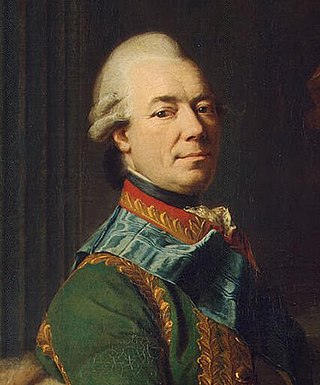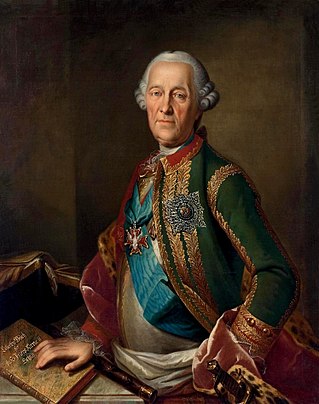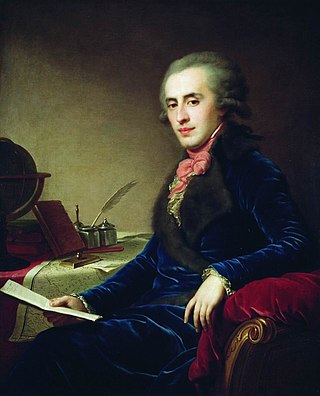
The Order of St. Andrew the Apostle the First-Called is the highest order conferred by both the Russian Imperial Family and by the Russian Federation . Established as the first and highest order of chivalry of the Russian Tsardom and the Russian Empire in 1698, it was removed from the honours system under the USSR before being re-established as the top Russian civil and military order in 1998.

Zakhar Grigoryevich Chernyshev was a Russian noble, courtier to Catherine the Great, Imperial Russian Army officer, and Imperial Russian politician in the 18th century.

Prince Grigory Aleksandrovich Potemkin-Tauricheski was a Russian military leader, statesman, nobleman, and favourite of Catherine the Great. He died during negotiations over the Treaty of Jassy, which ended a war with the Ottoman Empire that he had overseen.

Burkhard Christoph Graf von Münnich was a German-born army officer who became a field marshal and political figure in the Russian Empire. He carried out major reforms in the Russian Army and founded several elite military formations during the reign of Empress Anna of Russia. As a statesman, he is regarded as the founder of Russian philhellenism. Like his father, Münnich was an engineer and a specialist in hydrotechnology. He had the rank of count of the Holy Roman Empire of the German Nation.

Prince Platon Alexandrovich Zubov was the last of Catherine the Great's favourites and the most powerful man in the Russian Empire during the last years of her reign.

Count Sergey Kuzmich Vyazmitinov was a Russian general and statesman.

Prince Yakov Petrovich Shakhovskoy was a Russian statesman.

Count, then Prince Nikolay Ivanovich Saltykov, a member of the Saltykov noble family, was a Russian Imperial Field Marshal and courtier best known as the tutor of the eventual Tsar Paul I of Russia and his two sons, Constantine and Alexander.

The Collegium was a type of government departments in Imperial Russia. It was established in 1717 by Peter the Great to replace the system of Prikaz. They were housed in the Twelve Collegia building in Vasilyevsky Island, Saint Petersburg. In 1802, the Collegium was incorporated into and gradually replaced by the newly created system of Ministries.

Count Pavel Sergeevich Potemkin, sometimes spelled Potyomkin or Potiomkin was a Russian statesman, soldier, and writer.

Joachim Daniel von Jauch was a German-born architect who supervised the baroque development of Warsaw in Poland.

Prince Grigory Grigoryevich Orlov was a favourite of the Empress Catherine the Great of Russia, Prince of the Holy Roman Empire (1772), state and military figure, collector, patron of arts, and General-in-Chief.

Ministry of War of the Russian Empire, was an administrative body in the Russian Empire from 1802 to 1917.
The Collegium of Commerce is the central government agency created by Peter I to protect the trade.
The Collegium of Accounting was a Russian executive body (collegium), created in the government reform of 1717. It was de-established during the decentralising reforms of Catherine II of Russia. Its first President was Vasily Dolgorukov.

The Council at the Highest Court was the highest advisory institution in the Russian Empire that existed from 1768 to 1801.

The Cabinet of Ministers was the supreme state body established on November 4, 1731 by the decree of Empress Anna Ioannovna. On December 23, 1741, after the accession of Elizabeth Petrovna, it lost its powers and was transformed into the Personal Office of the Empress. In 1756, its functions were transferred to the Conference at the Highest Court.

The First Cadet Corps was a military school in Saint Petersburg.

Count Piotr Grigoryevich Chernyshev was a Russian Imperial nobleman, diplomat, privy counsellor, chamberlain, and senator.

















